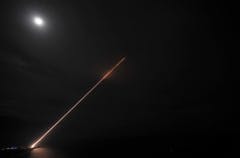Posted by Skyler Frink
NASHUA, NH., Nov. 12, 2011. The U.S. Navy and Marine Corps recently successfully fired the first shots of the Advanced Precision Kill Weapon System II (APKWS) from a UH-1Y helicopter, in preparation for fielding in 2012.
The successful shots, which took place at Naval Air Warfare Center Weapons Division in China Lake, California, Sept. 9-13, mark the start of APKWS testing on the UH-1Y, and are part of the program’s low-rate initial production phase.
Developed by BAE Systems in partnership with the U.S. government, the APKWS semi-active laser guidance section integrates with existing 2.75-inch rocket motors and warheads, giving aviators a highly precise weapon that is effective against soft and lightly armored targets while minimizing collateral damage. BAE Systems designed the system’s laser guidance and control section.
During the tests, Marine pilots fired a total of six shots from a UH-1Y against stationary targets with ranges varying from 1.5 to 5 kilometers. The initial shots from UH-1Y mark the first time a MK152 warhead has been fired from any aircraft, allowing safer operation aboard ships than the previous M151 warhead.
APKWS brings three operational benefits to those in combat. First, the BAE Systems guidance section is designed for compatibility with current 2.75-inch rocket motors, warheads, and fuzes, enhancing the capability of the existing 100,000-unit inventory of unguided rockets. Second, the system provides low collateral damage for precision engagement, while at the same time giving the military greater flexibility to engage the enemy. Finally, the unit cost is currently on track to meet the Navy’s objective against lower value targets.
The Navy assumed acquisition oversight of the APKWS program in 2008. In addition to its planned use on rotary-wing platforms, the Navy has entered into a Joint Concept Technology Demonstration program with the U.S. Air Force to evaluate the suitability of APKWS for fixed-wing platforms.
APKWS entered the first phase of production testing at China Lake’s facility last month. A launcher fired two laser-guided rockets and hit a stationary target. The test firings initiated a sequence of tests that allow the Navy to accept the guidance sections for Initial Operational Test and Evaluation, the final test phase prior to fielding the system.

